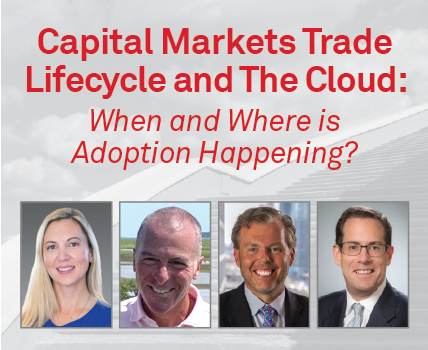Cloud Spreads Across the Trade Lifecycle, but Cost Remains a Key Barrier
Capital markets firms on both the buy and sell side are increasingly adopting cloud across the trade lifecycle. But cloud may not always be better, faster, cheaper, and success will depend on the business outcomes and costs.
That was the view shared by panelists at a Coalition Greenwich webinar, Capital Markets Trade Lifecycle and The Cloud: When and Where is Adoption Happening? The webinar was moderated by Audrey Blater, Senior Analyst at Coalition Greenwich.
Convergence and Divergence
Cloud has spread to every part of the trading lifecycle, from grid workloads and historical data storage to order and execution management systems on the buy side, and from real-time market data to risk analytics on the sell side. One exception is the post-trade lifecycle.
“Cloud adoption on the sell-side is accelerating. Their perception of cloud is evolving, but it lags a bit behind the buy side,” says Bill Ruvo, Head of Business Development, Capital Markets Americas, at the digital infrastructure firm Equinix.
“In terms of capturing real-time data, you'd be hard-pressed to make it through your day in the capital markets without touching a piece of data that came off cloud,” adds Adam Honore, Head of Financial Services Product at Amazon Web Services.
Business Drivers
According to a recent Coalition Greenwich study, cost is the overarching driver across all workflows, while security, availability and latency are driving adoption in the front office on the sell side.
Bill Ruvo agrees. “It’s latency-related for both, though the sell side puts higher priority on latency for front-office applications. The sell side is also more cost-driven.”
Steven Sadoff, Chief Information Officer at the financial services firm Cantor Fitzgerald has a different view: “The question is, should you do public cloud for your proprietary software. It’s also less about sell versus buy side, and more about the type of firm you are.”
So, cloud would be a “no-brainer” for a start-up, or for the “classical bursty workload,” or if a firm has inefficiency of scale. “It becomes more interesting in the middle of that barbell, as you have to look at business outcomes and return on investment. And the last segment is if you’re latency-sensitive—if you have a low latency need, it would be silly to put that in the cloud,” he says.
“I always find it interesting how situational the use of the cloud can be,” adds Audrey Blater. “In our research, although high-level trends exist, there is this overarching push by the business to achieve goals that plays a major role. In many cases, these goals are extremely nuanced.”
FICC on the Cloud
Among asset classes, adoption is accelerating in the fixed income, currency and commodity (FICC) space. According to Steven Sadoff, that’s because: “The FICC world has become more technology-centric, whether it's front, middle or back office. Or, whether it's electronic trading, or the workflow and efficiency tools required for growing volumes, or risk, or regulatory.”
Adds Bill Ruvo, “FICC markets have more recently become automated to improve speed, reduce costs and potentially minimize error. But this is resulting in firms adopting a hybrid model of co-location and cloud. It has to do with market structure. Asset classes that are highly liquid and actively traded tend to require co-location for effective and efficient execution.”
Barriers to Cloud and the Way Forward
Undoubtedly, set-up and operating costs are the biggest barriers to adoption, especially at scale. “The No. 1 challenge is cost. I think most people would say cheaper for certain use cases, but for a majority, maybe not so much,” states Steven Sadoff.
He adds, “People are looking more for business solutions as opposed to technology solutions today. You need something that's domain-specific and focused around real business needs, as opposed to, ‘I'm going to give you some memory, discs and cores, and I can do it in a T-shirt size small, medium or large.’”
On the other hand, paucity of tech talent will continue to be a big driver, as will capital expenditure to set up infrastructure. “Because by the time you get to it, it’s out of date,” says Adam Honore. The panelists agree that over a five-year horizon, pre-trade, front-office applications and, to some extent, risk, are less likely to migrate.
Will rising data volumes impact the rate of adoption? They will, along with the need to scale up and store data, believes Adam Honore, pointing out that high-performance data bases are a growth area already. “I'm always thrilled on high-spike days when one of our discount brokerage customers keeps humming along, while everybody else is starting to bottleneck,” he says.
Adds Bill Ruvo, “Co-location cloud and hybrid infrastructure will remain the norm for the foreseeable future, as both the buy and sell side adapt to new operating models.”

